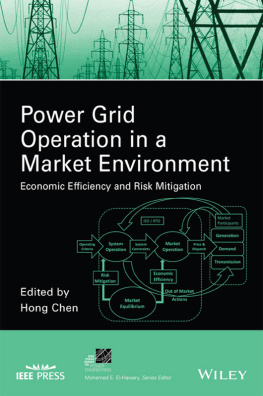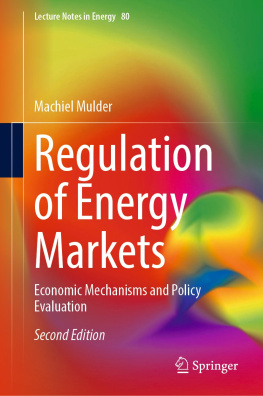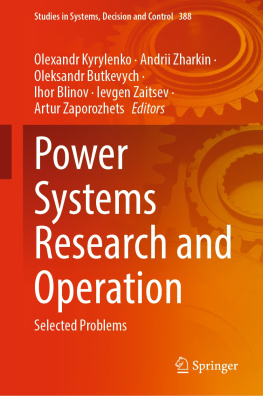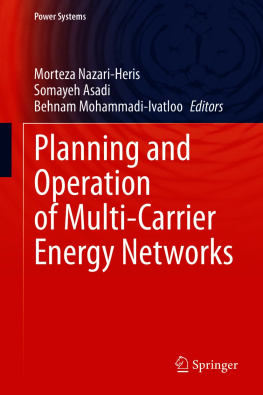
IEEE Press
445 Hoes Lane
Piscataway, NJ 08854
IEEE Press Editorial Board
Tariq Samad, Editor in Chief
| George W. Arnold | Xiaoou Li | Ray Perez |
| Giancarlo Fortino | Vladimir Lumelsky | Linda Shafer |
| Dmitry Goldgof | Pui-In Mak | Zidong Wang |
| Ekram Hossain | Jeffrey Nanzer | MengChu Zhou |
Kenneth Moore, Director of IEEE Book and Information Services (BIS)
Technical Reviewer
Xiao-Ping Zhang, University of Birmingham
POWER GRID OPERATION IN A MARKET ENVIRONMENT
Economic Efficiency and Risk Mitigation
Edited by
HONG CHEN
Copyright 2017 by The Institute of Electrical and Electronics Engineers, Inc. All rights reserved.
Published by John Wiley & Sons, Inc., Hoboken, New Jersey.
Published simultaneously in Canada.
No part of this publication may be reproduced, stored in a retrieval system, or transmitted in any form or by any means, electronic, mechanical, photocopying, recording, scanning, or otherwise, except as permitted under Section 107 or 108 of the 1976 United States Copyright Act, without either the prior written permission of the Publisher, or authorization through payment of the appropriate per-copy fee to the Copyright Clearance Center, Inc., 222 Rosewood Drive, Danvers, MA 01923, (978) 750-8400, fax (978) 750-4470, or on the web at www.copyright.com. Requests to the Publisher for permission should be addressed to the Permissions Department, John Wiley & Sons, Inc., 111 River Street, Hoboken, NJ 07030, (201) 748-6011, fax (201) 748-6008, or online at http://www.wiley.com/go/permission.
Limit of Liability/Disclaimer of Warranty: While the publisher and author have used their best efforts in preparing this book, they make no representations or warranties with respect to the accuracy or completeness of the contents of this book and specifically disclaim any implied warranties of merchantability or fitness for a particular purpose. No warranty may be created or extended by sales representatives or written sales materials. The advice and strategies contained herein may not be suitable for your situation. You should consult with a professional where appropriate. Neither the publisher nor author shall be liable for any loss of profit or any other commercial damages, including but not limited to special, incidental, consequential, or other damages.
For general information on our other products and services or for technical support, please contact our Customer Care Department within the United States at (800) 762-2974, outside the United States at (317) 572-3993 or fax (317) 572-4002.
Wiley also publishes its books in a variety of electronic formats. Some content that appears in print may not be available in electronic formats. For more information about Wiley products, visit our web site at www.wiley.com.
Library of Congress Cataloging-in-Publication Data is available.
ISBN: 978-1-118-98454-3
FOREWORD
SINCE THE INTRODUCTION of deregulated energy markets, the debate on reliability versus efficiency has continued. As many of the chapter contributors in this edited book, Power Grid Operationin a Market Environment: Economic Efficiency and Risk Mitigation, referenced, grid reliability continues to be a priority throughout established markets and regulated grid operations. While the reliability of power systems clearly remains the highest priority, the need for these operations to achieve an overall efficient use of resources must also remain a priority. This book's contributing authors tackle that aspect by addressing the existing efficiency challenges and introduce innovative approaches to continue to improve efficiency while maintaining reliability.
The book is a comprehensive technical handling of many of the challenges that deregulated grid operations face and must continue to improve upon. The book does not attempt to provide all of the technical possibilities, but instead identifies some key issues and offers some innovative approaches to the primary challenges that face grid operators.
The book contributors have worked for several years from a collaboration of one of the IEEE Power Energy Society teams focused on this topic. The book will be valuable as both an academic reference as well as a reference work for market system design. Each of the chapters takes an in-depth look at a particular aspect of efficient market design.
Chen and Liu present an excellent overview of system operation and market design in Chapter 1 including the stages of mature market design to include multi-settlement markets, capacity markets, and risk-based and dynamic markets. These authors also address the first efficiency aspectefficiency effects of reliable grid operations.
In Chapter 2, Baldick tackles another aspect of efficiency in market power and market mitigationin general, those inefficiencies caused by imperfect markets and competition. This chapter discusses some of the short-term and long-term inefficiencies and provides a nice tie-in to the effects of demand response (DR) on market power, serving as an introduction to the next chapter. In Chapter 3, Papalexopoulos discusses the impact of demand response resources on current market operations, and looks at a more efficient approach to handling the deployment of demand response resources. This chapter describes some of the current inefficiencies in DR deployment and the necessity of a new distributed approach to address the increase of these resources in grid operations.
A natural follow-on to the demand response discussion is the proliferation of intermittent resources and their impact to efficient market and grid operations. Makarov, Etingov, and Du tackle the increase of renewable resources and their effect on system performance. These authors offer several solutions for grid operators to incorporate the uncertainty of these renewable resources into the efficient dispatch for grid operations. This sets up a good introduction for the next chapter where Wu and Shahidehpour discuss unit commitment challenges in Chapter 5. Unit commitment continues to be a challenging algorithmic problem in organized markets, particularly when you look at the impact of demand response, renewables, and the optimization of energy and reserve commitment. This chapter presents several potential technical approaches to solve these challenges.
In Chapter 6, Jiang, Conejo, and Wang take the handoff and focus on the particular challenge of reserve requirements and how reserve commitments are valued in market operations. The approach in this chapter is unique as it is presented as a tutorial on reserve commitment with several approaches to adding additional efficiency to the determination and deployment of reserves.
The final two chapters take a different direction while completing the circle in addressing the various aspects of efficient operations. In chapter 7, Cheung and Wu tackle market efficiency affected by transmission outages and transmission-switching opportunities. The authors discuss the current approach which assumes a fixed network topology, and explore several methods to improve efficient operations through more dynamic approaches to both transmission outage scheduling and transmission switching. These approaches include the recognition of potential affects to forward market operations. The chapter provides a good transition to the final chapter where Tee and Ili present a planning framework to account for the value of operational flexibility in transmission planning.
Next page


















